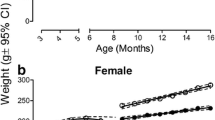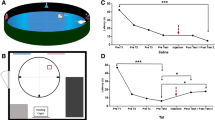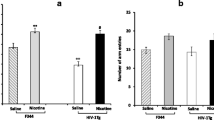Abstract
HIV-1 infection of the central nervous system impairs neural, cognitive, and behavioral functioning in patients despite antiretroviral therapy. However, studying mechanisms underlying HIV-1-related neurological and cognitive dysfunction has been limited without an adequate animal model. A novel, noninfectious HIV-1 transgenic (HIV-1Tg) rat model was recently created that expresses an HIV-1 provirus with a deletion of functional gag and pol genes. This HIV-1Tg rat reportedly develops clinical manifestations of human HIV disease and thus appears to mimic the persistent infection that results from the presence of HIV viral proteins in the host. We evaluated the HIV-1Tg rat model using the Morris water maze, a popular paradigm for testing learning and memory deficits in rodents. Because of congenital cataracts in HIV-1Tg rats, however, the traditional use of visual navigational cues in this paradigm were precluded. We first designed a modified Morris water maze and demonstrated that neurologically intact rats can effectively learn the water maze in the absence of visual cues and in the presence of non-visual navigation cues. We then tested HIV-1Tg rats in this modified Morris water maze. These HIV-1Tg rats showed a deficit in learning how to swim to the location of the hidden platform but did not show a deficit in their memory of the general location of the hidden platform. These results suggest that the noninfectious HIV-1Tg rat can be a valid model for the behavioral studies of HIV-related neurological dysfunction.






Similar content being viewed by others
References
Agbottah E, Zhang N, Dadgar S, Pumfery A, Wade JD, Zeng C, Kashanchi F (2006) Inhibition of HIV-1 virus replication using small soluble Tat peptides. Virology 345:373–389
Anderson ER, Boyle J, Zink WE, Persidsky Y, Gendelman HE, Xiong H (2003) Hippocampal synaptic dysfunction in a murine model of human immunodeficiency virus type 1 encephalitis. Neurosci 118:359–369
Baldi E, Lorenzini CA, Bucherelli C (2003) Task solving by procedural strategies in the Morris water maze. Physiol Behav 78:785–793
Barak O, Goshen I, Ben Hur T, Weidenfeld J, Taylor AN, Yirmiya R (2002) Involvement of brain cytokines in the neurobehavioral disturbances induced by HIV-1 glycoprotein120. Brain Res 933:98–108
Barrientos RM, Higgins EA, Sprunger DB, Watkins LR, Rudy JW, Maier SF (2002) Memory for context is impaired by a post context exposure injection of interleukin-1 beta into dorsal hippocampus. Behav Brain Res 134:291–298
Behnisch T, Francesconi W, Sanna PP (2004) HIV secreted protein Tat prevents long-term potentiation in the hippocampal CA1 region. Brain Res 1012:187–189
Berger JR, Arendt G (2000) HIV dementia: the role of the basal ganglia and dopaminergic systems. J Psychopharmacol 14:214–221
Burger C, Cecilia Lopez M, Feller JA, Baker HV, Muzyczka N, Mandel RJ (2007) Changes in transcription within the CA1 field of the hippocampus are associated with age-related spatial learning impairments. Neurobiol Learn Mem 87:21–41
Cain DP, Saucier D, Hargreaves EL, Wilson E, DeSouza JF (1993) Polypropylene pellets as an inexpensive reusable substitute for milk in the Morris milk maze. J Neurosci Methods 49:193–197
Cain DP, Boon F, Corcoran ME (2006) Thalamic and hippocampal mechanisms in spatial navigation: a dissociation between brain mechanisms for learning how versus learning where to navigate. Behav Brain Res 170:241–256
D’Hooge R, De Deyn PP (2001) Applications of the Morris water maze in the study of learning and memory. Brain Res Rev 36:60–90
Devan BD, Goad EH, Petri HL (1996) Dissociation of hippocampal and striatal contributions to spatial navigation in the water maze. Neurobiol Learn Mem 66:305–323
Dickie P, Felser J, Eckhaus M, Bryant J, Silver J, Marinos N, Notkins AL (1991) HIV-associated nephropathy in transgenic mice expressing HIV-1 genes. Virology 185:109–119
Galicia O, Sanchez-Alavez M, Diaz-Ruiz O, Sanchez Narvaez F, Elder JH, Navarro L, Prospero-Garcia O (2000) HIV-derived protein gp120 suppresses P3 potential in rats: potential implications in HIV-associated dementia. Neuroreport, 1:1351–1355
Garber ME, Wei P, KewalRamani VN, Mayall TP, Herrmann CH, Rice AP, Littman DR, Jones KA (1998) The interaction between HIV-1 Tat and human cyclin T1 requires zinc and a critical cysteine residue that is not conserved in the murine CycT1 protein. Genes Dev 12:3512–3527
Giunta B, Obregon D, Hou H, Zeng J, Sun N, Nikolic V, Ehrhart J, Shytle D, Fernandez F, Tan J (2006) EGCG mitigates neurotoxicity mediated by HIV-1 proteins gp120 and Tat in the presence of IFN-[gamma]: role of JAK/STAT1 signaling and implications for HIV-associated dementia. Brain Res 1123:216–225
Glowa JR, Panlilio LV, Brenneman DE, Gozes I, Fridkin M, Hill JM (1992) Learning impairment following intracerebral administration of the HIV envelope protein gp120 or a VIP antagonist. Brain Res 570:49–53
Griffin WC III, Middaugh LD, Cook JE, Tyor WR (2004) The severe combined immunodeficient (SCID) mouse model of human immunodeficiency virus encephalitis: deficits in cognitive function. J Neurovirol 10:109–115
Gonzalez-Scarano F, Martin-Garcia J (2005) The neuropathogenesis of aids. Nat Rev Immunol 5:69–81
Hollup SA, Kjelstrup KG, Hoff J, Moser MB, Moser EI (2001) Impaired recognition of the goal location during spatial navigation in rats with hippocampal lesions. J Neurosci 21:4505–4513
King JE, Eugenin EA, Buckner CM, Berman JW (2006) HIV tat and neurotoxicity. Microbes Infect 8:1347–1357
Kirsch I, Lynn SJ, Vigorito M, Miller RR (2004) The role of cognition in classical and operant conditioning. J Clin Psychol 60:369–392
Krucker T, Toggas SM, Mucke L, Siggins GR (1998) Transgenic mice with cerebral expression of human immunodeficiency virus type-1 coat protein gp120 show divergent changes in short- and long-term potentiation in CA1 hippocampus. Neurosci 83:691–700
Lawrence DM, Major EO (2002) HIV-1 and the brain: connections between HIV-1-associated dementia, neuropathology and neuroimmunology. Microbes Infect 4:301–308
Lindner MD, Plone MA, Schallert T, Emerich DF (1997) Blind rats are not profoundly impaired in the reference memory Morris water maze and cannot be clearly discriminated from rats with cognitive deficits in the cued platform task. Cogn Brain Res 5:329–333
Mackintosh NJ (2002) Do not ask whether they have a cognitive map, but how they find their way about. Psicologica 23:165–185
Mazzucchelli R, Amadio M, Curreli S, Denaro F, Bemis K, Reid W, Bryant J, Riva A, Galli M, Zella D (2004) Establishment of an ex vivo model of monocytes-derived macrophages differentiated from peripheral blood mononuclear cells (PBMCs) from HIV-1 transgenic rats. Mol Immunol 41:979–984
Morris RG (1989) Synaptic plasticity and learning: selective impairment of learning in rats and blockade of long-term potentiation in vivo by the N-methyl-d- aspartate receptor antagonist AP5. J Neurosci 9:3040–3057
Morris RGM, Garrud P, Rawlins JNP, O’Keefe J (1982) Place navigation impaired in rats with hippocampal lesions. Nature 297:681–683
Navia BA, Rostasy K (2005) The AIDS dementia complex: clinical and basic neuroscience with implications for novel molecular therapies. Neurotox Res 8:3–24
Nottet HS, Gendelman HE (1995) Unraveling the neuroimmune mechanisms for the HIV-1-associated cognitive/motor complex. Immunol Today 16:441–448
Packard MG, McGaugh JL (1992) Double dissociation of fornix and caudate nucleus lesions on acquisition of two water maze tasks: Further evidence for multiple memory systems. Behav Neurosci 106:439–446
Packard MG, Knowlton BJ (2002) Learning and memory functions of the basal ganglia. Annu Rev Neurosci 25:563–593
Prusky GT, West PWR, Douglas RM (2000) Reduced visual acuity impairs place but not cued learning in the Morris water task. Behav Brain Res 116:135–140
Pugh CR, Nguyen KT, Gonyea JL, Fleshner M, Wakins LR, Maier SF, Rudy JW (1999) Role of interleukin-1 beta in impairment of contextual fear conditioning caused by social isolation. Behav Brain Res 106:109–118
Pugh CR, Johnson JD, Martin D, Rudy JW, Maier SF, Watkins LR (2000) Human immunodeficiency virus-1 coat protein gp120 impairs contextual fear conditioning: a potential role in AIDS related learning and memory impairments. Brain Res 861:8–15
Reid W, Sadowska M, Denaro F, Rao S, Foulke J Jr, Hayes N, Jones O, Doodnauth D, Davis H, Sill A, O’Driscoll P, Huso D, Fouts T, Lewis G, Hill M, Kamin-Lewis R, Wei C, Ray P, Gallo RC, Reitz M, Bryant J (2001) An HIV-1 transgenic rat that develops HIV-related pathology and immunologic dysfunction. Proc Natl Acad Sci USA 98:9271–9276
Reid W, Abdelwahab S, Sadowska M, Huso D, Neal A, Ahearn A, Bryant J, Gallo RC, Lewis GK, Reitz M (2004) HIV-1 transgenic rats develop T cell abnormalities. Virology 321:111–119
Rossier J, Haeberli C, Schenk F (2000) Auditory cues support place navigation in rats when associated with a visual cue. Behav Brain Res 117:209–214
Sanchez-Alavez M, Criado J, Gomez-Chavarin M, Jimenez-Anguiano A, Navarro L, Diaz-Ruiz O, Galicia O, Sanchez-Narvaez F, Murillo-Rodriguez E, Henriksen SJ, Elder JH, Prospero-Garcia O (2000) HIV-and FIV-derived gp120 alter spatial memory, LTP, and sleep in rats. Neurobiol Dis 7:384–394
Santoro TJ, Bryant JL, Pellicoro J, Klotman ME, Kopp JB, Bruggeman LA, Franks RR, Notkins AL, Klotman PE (1994) Growth failure and AIDS-like cachexia syndrome in HIV-1 transgenic mice. Virology 201:147–151
Vigano A, Trabattoni D, Schneider L, Ottaviani F, Aliffi A, Longhi E, Rusconi S, Clerici M (2006) Failure to eradicate HIV despite fully successful HAART initiated in the first days of life. J Pediatr 148:389–391
Wang GJ, Chang L, Volkow ND, Telang F, Logan J, Ernst T, Fowler JS (2004) Decreased brain dopaminergic transporters in HIV-associated dementia patients. Brain 127:2452–2458
Whishaw IQ, Kolb B (1984) Decortication abolishes place but not cue learning in rats. Behav Brain Res 11:123–134
Whishaw IQ, Cassel JC, Jarrad LE (1995) Rats with fimbria-fornix lesions display a place response in a swimming pool: a dissociation between getting there and knowing where. J Neurosci 15:5779–5788
Yin HH, Knowlton BJ (2006) The role of the basal ganglia in habit formation. Nat Rev Neurosci 7:464–476
Zink WE, Anderson E, Boyle J, Hock L, Rodriguez-Sierra J, Xiong H, Gendelman HE, Persidsky Y (2002) Impaired spatial cognition and synaptic potentiation in a murine model of human immunodeficiency virus type 1 encephalitis. J Neurosci 22:2096–2105
Acknowledgement
SLC was partially supported by DA007058, DA016149, and DA019836.
Author information
Authors and Affiliations
Corresponding author
Rights and permissions
About this article
Cite this article
Vigorito, M., LaShomb, A.L. & Chang, S.L. Spatial Learning and Memory in HIV-1 Transgenic Rats. J Neuroimmune Pharmacol 2, 319–328 (2007). https://doi.org/10.1007/s11481-007-9078-y
Received:
Accepted:
Published:
Issue Date:
DOI: https://doi.org/10.1007/s11481-007-9078-y




